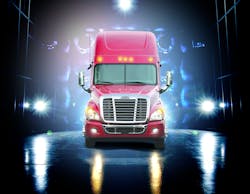Technology is changing the mindset on lifecycle management
Since 2011, heavy duty diesel engine manufacturers have improved fuel economy by 2 to 3 percent annually. Nevertheless, fuel can still account for one of the highest operating costs in a trucking operation, says Michael D. Spence, senior vice president of fleet services at Fleet Advantage, a provider of truck fleet business analytics and equipment financing (www.fleetadvantage.net).
In many cases, replacing older trucks with more fuel-efficient models will subsidize the higher initial price of a new truck, he maintains, and Fleet Advantage, which employs proprietary information analysis software for a growing customer base of fleets, has the data to back up that claim.
“We have a flexible leasing model that allows for immediate replacement of older trucks with newer, more efficient models that are actually less expensive to operate, even after factoring in the cost of the new unit,” says Spence. The fuel savings alone can subsidize 50 percent of the higher cost.
“The data is conclusive. “Replacing trucks sooner might be more advantageous in the long run because we can show exactly when a truck has reached its sweet spot--when new equipment can operate at a lower cost than retaining a current vehicle.”
OPERATING COST VARIANCES
Spence points to per mile operating cost variances between different generations of engines, including selective catalytic reduction (SCR)--2010 and newer engines with this type of diesel engine emissions control technologies; diesel particulate filter (DPF)--2008 to 2010 diesels with exhaust gas recirculation (EGR) emissions control technologies and a DPF; and pre DPF engines--2007 and older.
“Total cost per mile for engine related maintenance and repair expenses is two to four times higher depending on year of service,” he says.
As an example, he uses statistics from a 1,500-truck fleet that decided to replace all of its trucks with DPF engines early.
“They realized almost immediately that the DPF-equipped units were costing $0.06 to $0.10 per mile more to operate than pre-DPF trucks, and results on SCR units after three to four years prove that costs for those engine systems are lower.
“There are also indications that the cost per mile on DPF-equipped engines would have actually been higher in early years if warranty coverage had not captured much of the expense.”
Spence says the specific maintenance and repair issues with DPF engines that are not found in SCR engines include:
- Repeated EGR failure because of heavy exhaust gas recirculation.
- Coolant leaks that result in contaminated exhaust that destroys the DPF catalyst.
- Increases in soot that lead to more frequent regeneration and fuel injector replacement.
- Early turbochargers that were prone to failure.
- Frequent regeneration that destroys the DPF catalyst and filter media.
- Engine oil consumption issues which require forced regeneration.
Operating expenses, and specifically fuel costs related to more frequent DPF cleaning in older engines, were not only higher, they led to excess downtime, which poses driver and customer service issues, he notes.
“The use of information technology and analysis to achieve the lowest cost of ownership is causing a rethinking of the mindset behind vehicle replacement cycles,” observes Spence. “With data driven analysis capabilities, trucking operations can stop asking ‘How many years can I run this truck’ and effectively answer the question, ‘How many years should I run this truck?’”
About the Author

